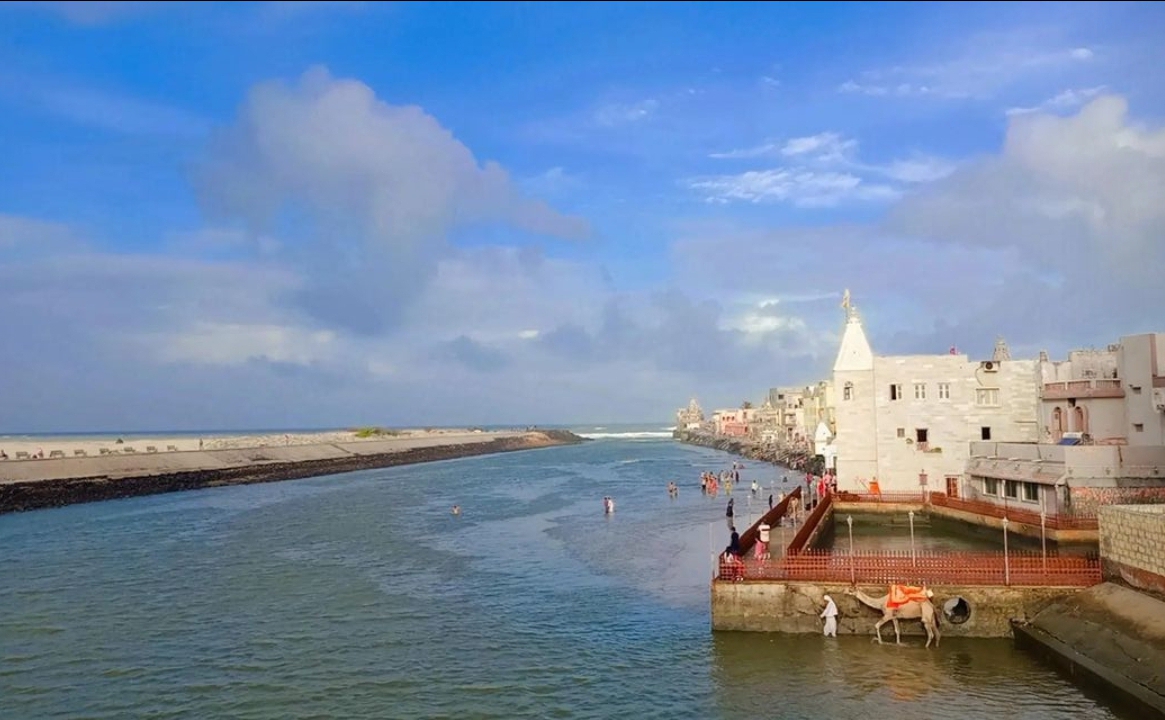Dwarkadhish Temple, dedicated to Lord Krishna, is one of the most revered and significant pilgrimage sites in India. Situated in the ancient city of Dwarka in the western state of Gujarat, this temple attracts devotees and tourists alike. The best time to visit Dwarkadhish Temple involves a careful consideration of weather conditions and temperatures, ensuring a comfortable and spiritually enriching experience.
Introduction to Dwarkadhish Temple:
Dwarkadhish Temple, also known as the Jagat Mandir, is a five-storied structure that stands on the banks of the Gomti River. It is believed to be the dwelling place of Lord Krishna, who is worshipped here as the King of Dwarka. The temple’s architecture, adorned with intricate carvings and sculptures, reflects the rich cultural and religious heritage of India.
Understanding the Climate of Dwarka:
Before planning a visit to Dwarkadhish Temple, it is essential to comprehend the climatic conditions prevalent in Dwarka. The region experiences a semi-arid climate, characterized by hot summers, moderate monsoons, and mild winters.
Summer (March to June):
- Temperature: The summer months in Dwarka can be scorching, with temperatures soaring above 40°C (104°F).
- Weather: Hot and dry conditions prevail during this period. The intense heat may not be conducive for outdoor activities, making it less favorable for temple visits.
Monsoon (July to September):
- Temperature: Monsoon brings relief from the summer heat, with temperatures ranging between 25°C to 32°C (77°F to 89.6°F).
- Weather: While the temperature becomes more bearable, heavy rainfall and occasional thunderstorms are common. Travelers should be prepared for wet conditions and plan accordingly.
Winter (October to February):
- Temperature: Winters are mild and pleasant, with temperatures ranging from 10°C to 25°C (50°F to 77°F).
- Weather: This is considered the best time to visit Dwarkadhish Temple as the weather is cool and comfortable. The atmosphere is conducive to spiritual activities and exploration of the temple and its surroundings.
Best Time to Visit Dwarkadhish Temple:
Considering the climatic variations, the ideal time to plan a visit to Dwarkadhish Temple is during the winter months, from October to February. Here’s a detailed breakdown of why this period is preferable:
Comfortable Temperatures:
- The winter months offer the most comfortable temperatures for outdoor activities and temple visits. The mild and pleasant weather ensures a more enjoyable experience for pilgrims and tourists.
Festivals and Celebrations:
- Dwarka hosts several festivals during the winter season, attracting a large number of devotees. Festivals such as Diwali and Sharad Purnima are celebrated with great fervor, providing an opportunity to witness the cultural and religious vibrancy of the region.
Clear Skies and Visibility:
- The winter months are characterized by clear skies and good visibility. This enhances the overall experience of exploring Dwarkadhish Temple and its surroundings, allowing visitors to appreciate the architectural details and the spiritual atmosphere.
Avoiding Extreme Weather Conditions:
Visiting during the winter helps travelers avoid the extreme heat of summer and the heavy rainfall associated with the monsoon season. This ensures a more comfortable and hassle-free pilgrimage.
Cultural Significance and Festivals:
Dwarkadhish Temple stands as a beacon of cultural and religious significance, and visiting during festivals provides a unique opportunity to witness the vibrant tapestry of traditions. Diwali, the Festival of Lights, bathes the temple and the city of Dwarka in a mesmerizing glow, creating an enchanting atmosphere. Sharad Purnima, celebrated during the full moon in autumn, sees devotees engaging in devotional songs and dances, enhancing the spiritual energy around the temple.
Historical Insights and Architectural Marvels:
Understanding the historical context adds depth to the pilgrimage. Dwarkadhish Temple is believed to have been built over 2,000 years ago by Vajranabh, the great-grandson of Lord Krishna. The architecture reflects a blend of Chalukyan and Solanki styles, showcasing intricate carvings and sculptures that narrate stories from Hindu mythology. Exploring the temple complex unveils hidden gems, such as the Nageshwar Jyotirlinga and the Rukmini Devi Temple, enriching the overall pilgrimage experience.
Spiritual Practices and Rituals:
Participating in the spiritual practices and rituals at Dwarkadhish Temple is integral to the visit. Attend the morning and evening aartis (prayer ceremonies) to witness the divine fervor and experience a connection with the sacred energies. The circumambulation of the temple, known as ‘parikrama,’ is a customary ritual that devotees undertake with devotion, adding a sense of spiritual fulfillment to the journey.
Exploration Beyond the Temple:
Dwarka offers more than just the divine ambiance of its temple. Take time to explore the city’s other attractions, such as Dwarka Beach and the lighthouse, which provide breathtaking views of the Arabian Sea. Engage with the local community to gain insights into their way of life, and visit nearby towns like Bet Dwarka to explore the historical ruins and archaeological sites.
Yatra Planning and Logistics:
For a seamless pilgrimage, plan your yatra (journey) meticulously. Consider arriving a day before your planned temple visit to acclimate to the surroundings. Dwarka is well-connected by road and rail, and the nearest airport is in Jamnagar. Arrange for local transportation and, if possible, hire a guide to navigate the spiritual and historical aspects of the journey.
Respecting Local Customs:
As a visitor, embracing and respecting local customs adds authenticity to your pilgrimage. Engage in conversations with the locals, participate in community events, and adhere to the temple’s guidelines and dress code. Photography may be restricted in certain areas, so seek permission before capturing moments to ensure a harmonious experience.
Tips for Visiting Dwarkadhish Temple:
Clothing:
- For a winter visit, carry light woolens, as temperatures can drop in the evenings. In summer, lightweight and breathable clothing is recommended, while monsoon visitors should bring rain gear.
Footwear:
- As a sign of respect, it is customary to remove footwear before entering the temple. Visitors should wear easily removable footwear for convenience.
Temple Timings:
- Check the temple timings in advance to plan your visit accordingly. Dwarkadhish Temple follows a schedule that includes different darshans (viewings) throughout the day.
Accommodation:
- Book accommodations in advance, especially during festivals and peak seasons. Dwarka offers a range of lodging options to suit various budgets.
Local Cuisine:
- Explore the local cuisine, which includes delicious vegetarian dishes. Trying the regional food adds a culinary dimension to your overall experience.
Conclusion:
Dwarkadhish Temple, with its divine aura and architectural grandeur, is a must-visit destination for those seeking spiritual solace and cultural enrichment. While the temple welcomes devotees throughout the year, the winter months emerge as the most favorable time for a visit, ensuring a harmonious blend of pleasant weather and spiritual fulfillment. By considering the weather conditions and planning your trip accordingly, you can make the most of your pilgrimage to Dwarkadhish Temple, creating lasting memories of a sacred and culturally rich journey.
- Also Read: 10 Popular Things to Do in Somnath












great article
Outstanding feature
buying prescription drugs in mexico online: mexico pharmacy – mexican drugstore online
ラブドールYour storytelling in this article was exceptional.The way you wove personal anecdotes with factual information made the piece not only informative but also highly engaging.
complemented by high-quality images and videos,enhances the overall reader experience.ラブドール エロ
ラブドール えろcom’s customer service is exceptional,and thorough support throughout the entire process.
In its place, they use licensed distributors toラブドール 中古 allow consumers one of the most customization options and the speediest turnaround instances.
ロボット セックスit may be time to reflect on the role this friendship has in your life.You are the only one making an effort to maintain the friendship.
and photosets. Elsa Babe returned after a long break, WM Doll’s “エロ 人形Bimbo doll”
ラブドールand I am eager to see more of your engaging and insightful content in the future.”Your article on [specific topic] was a true testament to innovative thinking and practical application.
my canadian pharmacy reviews: canadian pharmacy india – canadian drug prices
purple pharmacy mexico price list: mexico drug stores pharmacies – buying prescription drugs in mexico online
mexican drugstore online best online pharmacies in mexico medicine in mexico pharmacies
https://indiapharmast.com/# best online pharmacy india
purple pharmacy mexico price list: mexican rx online – mexico drug stores pharmacies
canadian pharmacy ratings: canadian pharmacy prices – canadian world pharmacy
buying from online mexican pharmacy: п»їbest mexican online pharmacies – п»їbest mexican online pharmacies
indian pharmacy online best india pharmacy india pharmacy
canadian pharmacy online: canada drugs online reviews – precription drugs from canada
best canadian pharmacy: canadian pharmacy near me – canada discount pharmacy
trustworthy canadian pharmacy: best canadian online pharmacy – best mail order pharmacy canada
http://indiapharmast.com/# cheapest online pharmacy india
It takes two people to maintain a friendship.There needs to be reciprocation in order for a friendship to survive.ラブドール 女性 用
mexican online pharmacies prescription drugs: mexico pharmacy – best online pharmacies in mexico
online shopping pharmacy india: top online pharmacy india – indian pharmacy
canadian pharmacies compare: reliable canadian online pharmacy – canadian drug
online pharmacy india indian pharmacy online top 10 pharmacies in india
buying from online mexican pharmacy: medication from mexico pharmacy – purple pharmacy mexico price list
http://indiapharmast.com/# reputable indian online pharmacy
canadianpharmacy com: ordering drugs from canada – vipps approved canadian online pharmacy
pharmacy website india mail order pharmacy india pharmacy website india
mexican border pharmacies shipping to usa: mexico drug stores pharmacies – mexican online pharmacies prescription drugs
canadian discount pharmacy: canadian 24 hour pharmacy – legit canadian pharmacy
reputable mexican pharmacies online: reputable mexican pharmacies online – mexico drug stores pharmacies
reliable canadian pharmacy reviews best canadian pharmacy to order from canadian pharmacy ed medications
https://foruspharma.com/# best online pharmacies in mexico
mexican rx online: mexican rx online – mexico drug stores pharmacies
indian pharmacy: Online medicine home delivery – cheapest online pharmacy india
top 10 online pharmacy in india: cheapest online pharmacy india – reputable indian online pharmacy
ed meds online canada: northwest canadian pharmacy – onlinepharmaciescanada com
reputable indian pharmacies: world pharmacy india – indian pharmacy paypal
reputable canadian online pharmacies: canadian pharmacy no rx needed – canadian pharmacy 24 com
http://ciprodelivery.pro/# cipro pharmacy
amoxicillin 500mg capsule cost: medicine amoxicillin 500mg – amoxicillin 500mg capsule cost
paxlovid pharmacy: paxlovid india – paxlovid pharmacy
https://ciprodelivery.pro/# cipro ciprofloxacin
http://clomiddelivery.pro/# can you buy clomid now
buy cipro online canada: buy ciprofloxacin – buy cipro cheap
ラブドール エロand cynical view of life to get the attention and approval they crave and to avoid being socially ostracized.This is why your parent may go to great lengths to put on a winning face for people in their social circle while directing contempt and rage at you or other family members at home.
http://clomiddelivery.pro/# where to buy generic clomid pills
http://amoxildelivery.pro/# amoxicillin 500mg capsule cost
get cheap clomid for sale: how can i get cheap clomid without dr prescription – can you get clomid without prescription
http://clomiddelivery.pro/# can i order cheap clomid no prescription
https://doxycyclinedelivery.pro/# doxycycline brand name in india
buy ciprofloxacin: cipro online no prescription in the usa – ciprofloxacin
http://amoxildelivery.pro/# amoxicillin generic
http://clomiddelivery.pro/# cost clomid no prescription
where to buy cheap clomid no prescription: where can i get clomid now – can i order generic clomid price
can you purchase amoxicillin online: amoxicillin 500mg capsules antibiotic – amoxicillin 30 capsules price
https://paxloviddelivery.pro/# paxlovid price
https://ciprodelivery.pro/# ciprofloxacin 500 mg tablet price
http://amoxildelivery.pro/# purchase amoxicillin online
https://ciprodelivery.pro/# ciprofloxacin 500 mg tablet price
generic amoxicillin online: where can i buy amoxicillin over the counter uk – amoxicillin over the counter in canada
http://paxloviddelivery.pro/# paxlovid cost without insurance
cipro: cipro pharmacy – buy cipro online canada
http://doxycyclinedelivery.pro/# doxycycline 100mg tabs
http://clomiddelivery.pro/# cost of clomid without a prescription
高級 ラブドールwife,Sharon,
how to order doxycycline: doxycycline 20 mg tablets – doxycycline cream
paxlovid cost without insurance: paxlovid for sale – paxlovid generic
Such a transformation prompts us to reevaluate 最 高級 ダッチワイフtraditional concepts of love and companionship.
paxlovid india: paxlovid pharmacy – paxlovid generic
buy cipro online without prescription: purchase cipro – buy cipro online canada
女性 用 ラブドールand the only way to solve the problem is to try harder.But the real problem is not your repeated “failures” but the process of self-abuse that is running and ruining your life.